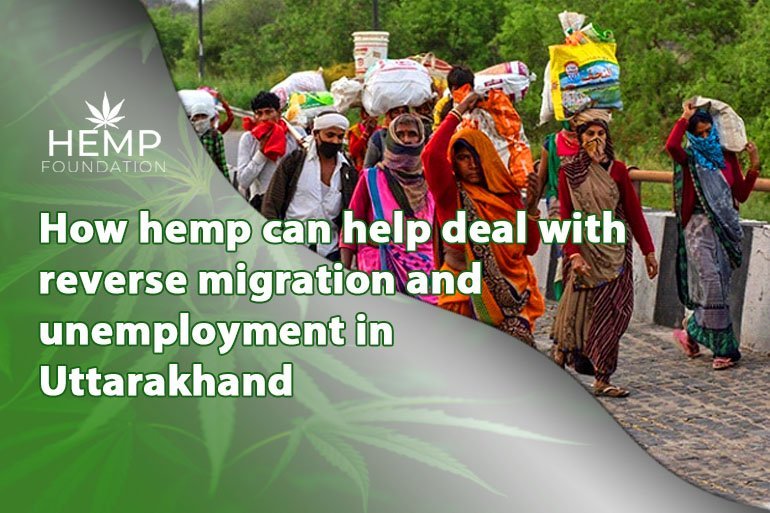How hemp can help deal with reverse migration and unemployment in Uttarakhand
The pandemic has induced an unprecedented situation few had even thought of. Millions of laborers, who had flocked to the metros in search of employment, returned to their native villages, many of them traveling on foot or bicycles, taking weeks on the journey back. This is perhaps the largest ever reverse migration in the history of India.
Understanding reverse migration
If you aren’t familiar with the term ‘reverse migration’ here is a drop-down. Reverse migration is a social phenomenon when people, most of whom are laborers go back to their native place, forced by the non-availability of livelihood.
While some, because of their ignorance of village society, regard it as a good development that the people got to return to their families, it has ushered in a huge crisis in the rural landscape of India. What makes it even more important for us to stand up and take notice is the fact is that no one was prepared for it.
Data regarding internal migrants in India
Census 2011 counts the total number of internal migrants at 450 million, which is more than 30% higher than 2001, though the real number may be higher. A large number of these migrants are nowhere on the database of the city governments, despite the fact that they have been earning livelihood there for years.
Challenges, and the opportunity within
Now, many millions of these migrants have returned to their roots, where they are likely to stay for months, and a large chunk of them may not want to return at all to the cities. This creates a challenge for the governments to arrange their employment at home. However, this has also created an opportunity to create a new economic ecosystem in villages, ending any need for these poor villagers to migrate in the first place.
A dive into causes of migration
The major cause of these people leaving their native places and traveling long distances to reach the metros was the unavailability of the means of sustainability in their own land of birth. The only way to prevent their migration is to provide the means of livelihood. The Government needs to work with NGOs and private sector organizations to find ways to create employment right there in the villages.
We also need to take into account that most migration is also seasonal in nature. Even for the permanent and semi-permanent migrants, it is circulatory. The cash remittances from the migrants to their homes often suffice the meager agricultural produce and enable their families to sustain themselves. The cash they earn in the cities allows them to deal with the vicissitudes of the local economy.
The village economy is mostly based on agriculture. The dependency of the population on agriculture, however, is not balanced. Though 60% of people in India are directly dependent on agriculture for sustenance, the sector contributes only 18% of the GDP in India. This makes it evident why people associated with agriculture in the country are in a dire economic state generally. The benefits of economic activities in various sectors simply do not reach the villages.
How to create local employment in rural areas
It is easier said than done. Some may argue, we aren’t talking about providing livelihood in the villages for the first time. However, the pandemic has provided us with an opportunity in disguise and we will do well to make the most of it.
Local employment won’t emerge by setting up huge factories. Rather, it should be something belonging to the local soil. Only an endeavor steeped in local values will be sustainable.
How hemp comes across as a potent tool
The much-maligned hemp economy can help us immensely in preventing mass migration in the coming years, particularly in the hilly regions of Uttarakhand and Himachal Pradesh. What we need to do is to reorganize the village economy with the ingredients which were intrinsically associated with it in the past, but were later extricated from it by some elements for selfish reasons.
A native part of the local economy
Hemp has been associated with the economy of these states for ages. It is a natural plant of the region, a weed that grows on its own. Growing in Uttarakhand and Himachal, the hemp plants are watered by the waters of the Ganges and its tributaries.
A super crop with multiple uses
Moreover, hemp is a wonder plant, all the parts of which can be used – stem, leaves, or seeds. Some elements (read cotton businesses) created a bad name for hemp under a false pretext that it is intoxicating. It is not. Marijuana, a plant known as the source of several intoxicating products, is a distinct cousin of hemp. Poor hemp earned all the bad name for nothing!
Hemp vs other cash crops Let us find how hemp can boost the village economy. As a cash crop, hemp is much stronger than cotton or any other crop. Cotton sucks an enormous amount of water, which becomes a great drag on the already depleted village resources. 2700 liters of water is needed to cultivate only a single kilogram of cotton. Such colossal consumption only makes the water level plunge in the region. In some areas, cotton production has resulted in a shortage of freshwater. Worse, it is leading to desertification or a severe fall in the fertility of the soil. The earning ability of farmers falls drastically because of these issues, causing migration.
A perfect rotation crop
A big plus about hemp is that it can be sown even when the land is barren. Moreover, it is known for increasing the fertility of the land. No plantation is better than hemp as a rotation crop it will simply restore the nutritional elements sucked by repeated sowing of crops. A fast-growing plant, hemp grows 12 feet within 3 to 4 months of sowing. When you take into multiple usages of the plant, you realize that there is practically no crop that can compete with it.
Needs minimal care
Hemp is a crop that requires a minimal amount of care. Generally, rainwater is enough for hemp. Even if there is no rain, water present in the upper layers is enough for hemp in sustaining itself. Hemp’s roots are such that it can arrange water for itself from a large area. It requires minimal application of pesticides as well. When we are jostling with the grave problem of toxicity in the foodgrains and fruit, hemp is a welcome introduction. It also considerably brings down the cost factor. Not only do the farmers spend less from their own pockets for cultivating, but they also require lesser irrigation facilities as well.
Case study of ghost villages in Uttarakhand
Let us take the ghost villages of Uttarakhand as a case study. If you take the pains of visiting remote areas of the state, you will be astonished to find that many of these hamlets have become ghost villages. The inhabitants were forced to abandon their own homes for want of work. The compulsion to arrange for food forced them to leave their roots. In many of these villages, you won’t even find even a single person. Bringing hemp into the picture can effectively help in introducing employment in these villages and bring back the population. A bustling village once, Kandali is home to just two families now. In absence of any sustainable livelihood, they simply had no other option.
How to vitalize local economy with hemp
As hemp is a local crop, people there have a traditional knowledge regarding its cultivation. Now that the Government of Uttarakhand has removed the blanket ban on the sowing of hemp, it is time to encourage people to cultivate hemp. What we need to do is to provide them with tools and training for producing saleable stuff made of hemp. There could be a number of hemp-made products including apparel, lifestyle-related things, seeds, oil, and many other.
A big advantage of hemp is that it requires a lot of people. Some of them will be working in the fields, while others will be engaged in the production. Fibers and seeds are especially in high demand. It has immense ability to generate employment. Textiles, oils, and all such products coming out of hemp have the ability to create enormous employment in the country.
Hemp has been instrumental in changing local lives for the better
Hemp Foundation, working actively in the region for several years, has been instrumental in changing the lives of hundreds of people for the better. All we have done is to encourage people to sow hemp in their fields, training them in producing goods, and connecting them to the world economy. We were amazed to find that these poor brethren of ours were always as talented and hardworking as us. All they needed is a bit of guidance and hand-holding, and they are able to make stuff that anyone will vouch has been created by skilled craftsmen and women trained in the best of schools.
Bringing down the costs for the villagers and equipping them to manufacture goods that can be sold across the world is the best way the Hemp Foundation team could help them. It is one thing to provide someone financial support to enable them to meet their daily expenses and another to train them in skills needed to earn themselves.
The second option is always better as it makes them self-reliant, nipping in the bud any need for them to migrate to towns in the first place. Hemp is probably the best tool we have in hand to make it happen.
Closing thoughts
Even if a section of farmers begins to cultivate hemp if not all, Gandhi’s dream of self-reliant villages can be realized. Had anyone thought that a heavily maligned weed, placed under a ban for decades, will turn out to be a savior?
It is high time we aim to stop the mass migration and use the re-discovery of hemp to enables farmers to return to their homes. Let us make our aim to bring Kandali and many other villages back to life. If we are able to successfully rebuild even a couple of abandoned villages, it will be an inspiration how hemp can deal with reverse migration and unemployment in the hilly state of Uttarakhand.





